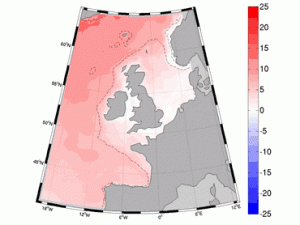Research confirms that large areas of the shallow shelf-seas around Europe are vulnerable to oxygen deficiency, and that there is more variability in how these areas absorb carbon dioxide than previously thought, according to a new reanalysis published by NCEO researchers.
The work is relevant for marine policy and improved climate modelling.
Shelf-sea ecosystems are a hugely important natural resource, providing about 90% of global fish catches. Worryingly, rising water temperatures and eutrophication in these areas can reduce the amount of dissolved oxygen in the water, which could trigger sudden and massive death of marine species with a direct impact on the global community.
Improving our understanding of these ecosystems and how they respond to climate change is vital for marine policy. But they are particularly complex and difficult to model and monitor, being at the interface between processes in the deep ocean, land and sediments, and atmosphere.
Recent advances in computer modelling and improvements in how we interpret satellite data and its uncertainties have enabled a research team led by Stefano Ciavatta based at Plymouth Marine Laboratory to run the first decade-long reanalysis of northwest European shelf-sea biogeochemistry.
The researchers quantified levels of ten relevant indicators in the northwest European shelf, including chlorophyll, dissolved oxygen and nutrients. And in contrast to previous studies, the team calculated confidence levels for their estimates. This improvement will help policymakers to exploit the output – for example by being able to quantify the margins of error for avoiding unsafe levels of pollutants in coastal waters.
Remote sensing of the ocean is limited to the sea-surface and scattered ocean buoys, so to fill in the gaps and obtain realistic estimates, the team integrated these data with coupled physical-biogeochemical models for the northwest European shelf. The reanalysis for 1998-2009 corrects the model estimates towards the observations, taking into account errors in the model and the observations. The observations used in this work were provided by Ocean Colour – Climate Change Initiative of the European Space Agency.
Then in two policy-relevant case studies, the team extracted information to assess the vulnerability of the bottom waters of the shelf to oxygen deficiency and the variability of uptake of atmospheric carbon dioxide.
Extracting information for policy-relevance
In the first case study the team found that 325,000 square kilometres of Europe’s shelf-seas are seasonally prone to oxygen deficiency, with a 100% confidence level – meaning that out of 100 model simulations, all estimated oxygen levels fell below 6 mg/L, a threshold defined by the OSPAR Commission for safeguarding the ecosystem of the North East Atlantic. This is an area roughly the size of Germany.
Extending to a 1% confidence criterion increased the vulnerable region by 40,000 square kilometres. They found a clear seasonal pattern, with lowest values of dissolved oxygen in August/September and rising over winter into spring. However for some shelf locations near estuaries, oxygen deficiency persists into winter.
The team say further processing could enable researchers to examine the links between oxygen deficiency and human pressures, for example from rivers containing fertilizer run-off. “We are making the output available to researchers and policymakers through our data portal and would be happy to collaborate in such analysis,” says Ciavatta. Policy applications could include regulating the timing of bottom trawling, and the location of aquaculture systems, for example.
In the second case study the team examined the shelf-sea uptake of atmospheric carbon dioxide over the decade, and found that the North East Atlantic is a net sink of carbon dioxide.
Generally, carbon uptake increases from south to the northern colder waters, and from coast towards the open ocean, but variability means that a weak carbon source can switch into a sink due to interannual fluctuations of the ecosystem, chiefly due to changing biological processes. The total uptake varies between 36-46 teragrams of carbon per year, at a 90% confidence level.
Results from this work will support the Marine Environment Monitoring service of the European Copernicus Program.
“We expect that methods and experiences developed in this research area will help to integrate shelf-sea ecosystems in Earth System Models for enhancing the accuracy of global climate simulations,” says Ciavatta.
“We hope that scientists, policymakers and end-users will exploit the freely available output of the reanalysis for their own studies and applications, hopefully to safeguard the shelf-sea health and the wellbeing of populations,” he added.
The biogeochemical estimates provided by this work are available at the PML data portal.
The research was published online on 12 February 2016 in Journal of Geophysical Research: Oceans, doi:10.1002/2015JC011496.
Image credit: FreeImages.com/Jesper Baerentzen
